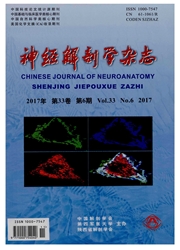

 中文摘要:
中文摘要:
目的:明确5-HT1A受体是否参与吻侧无颗粒岛叶皮层(rostral agranular insular cortex,RAIC)介导的抗炎性持续性痛效应。方法:采用行为药理学实验方法观察RAIC内微量注射选择性5-HT1A受体激动剂和拮抗剂对福尔马林诱发的伤害性行为(缩足反应)的影响。结果:RAIC内微量注射选择性5-HT1A受体的激动剂8-OH-DPAT(5.0μg/0.5μl)明显抑制福尔马林诱发的大鼠缩足反应;向RAIC内提前5min预先微量注射5-HT1A受体拮抗剂NAN-190(10μg/0.5μl)则可拮抗8-OH-DPAT(5.0μg/0.5μl)对缩足反应的抑制效应;RAIC内单独注射NAN-190对福尔马林诱发的大鼠缩足反应没有影响。结论:5-HT1A受体参与RAIC介导的抗炎性持续性痛效应。
 英文摘要:
英文摘要:
Objective:To investigate whether 5-hydroxytryptamine 1A(5-HT1A)receptor in the rostral agranular insular cortex(RAIC)are involved in mediating the descending anti-persistent inflammatory nociceptive effects.Methods:The effects of microinjection of the selective 5-HT1A receptor agonist and antagonist on the formalin-evoked nociceptive behavior(flinching response)using animal behavior pharmacological method.Results:Microinjection of the selective 5-HT1A receptor agonist 8-OH-DPAT(5.0 μg/0.5 μl)into the RAIC depressed the formalin-evoked flinching responses,which was antagonized by pre-treatment with the selective 5-HT1A receptor antagonist NAN-190(10 μg/0.5 μl)in the same RAIC site.Microinjection of NAN-190 alone into the RAIC has no influence on the formalin-evoked flinching responses.Conclusion:These results suggest that 5-HT1A receptor in the RAIC are involved in mediating the descending antinociceptive effects on the persistent inflammatory nociception.
 同期刊论文项目
同期刊论文项目
 同项目期刊论文
同项目期刊论文
 Activation of mu-opioid receptors in thalamic nucleus submedius depresses bee venom-evoked spinal c-
Activation of mu-opioid receptors in thalamic nucleus submedius depresses bee venom-evoked spinal c- Activation of serotonin 1A receptors in ventrolateral orbital cortex depresses persistent nociceptio
Activation of serotonin 1A receptors in ventrolateral orbital cortex depresses persistent nociceptio The role of dopamine receptors in ventrolateral orbital cortex-evoked anti-nociception in a rat mode
The role of dopamine receptors in ventrolateral orbital cortex-evoked anti-nociception in a rat mode The role of dopamine receptors in ventrolateral orbital cortex-evoked antinociception in a rat forma
The role of dopamine receptors in ventrolateral orbital cortex-evoked antinociception in a rat forma 期刊信息
期刊信息
